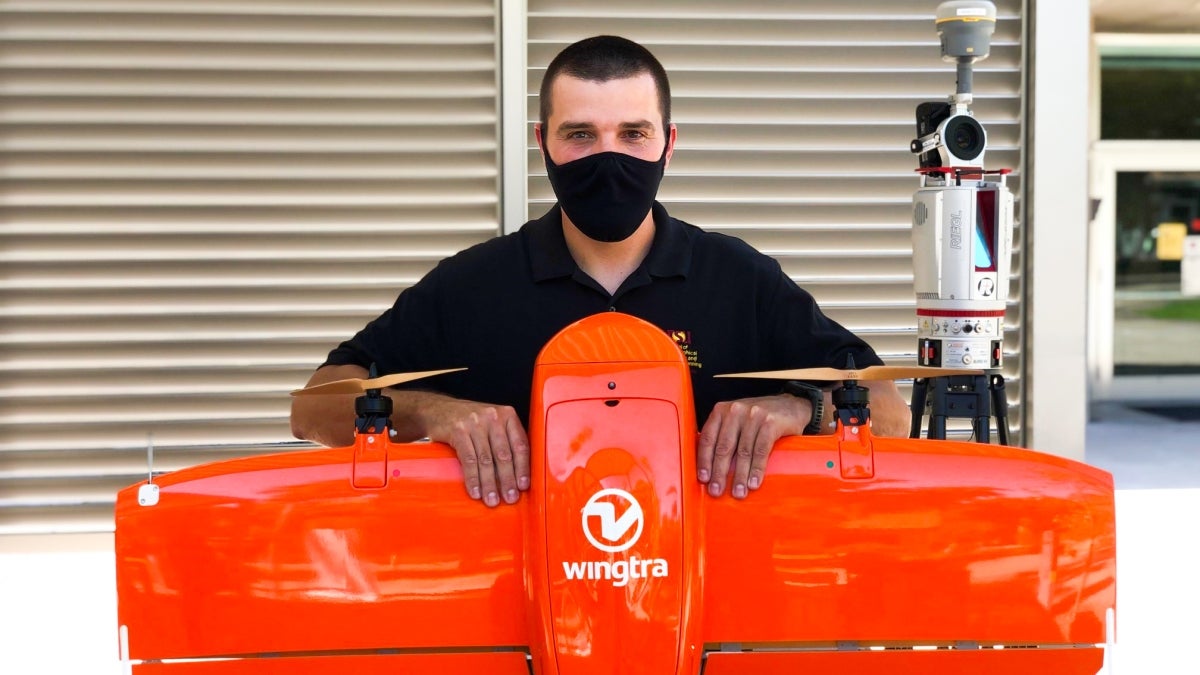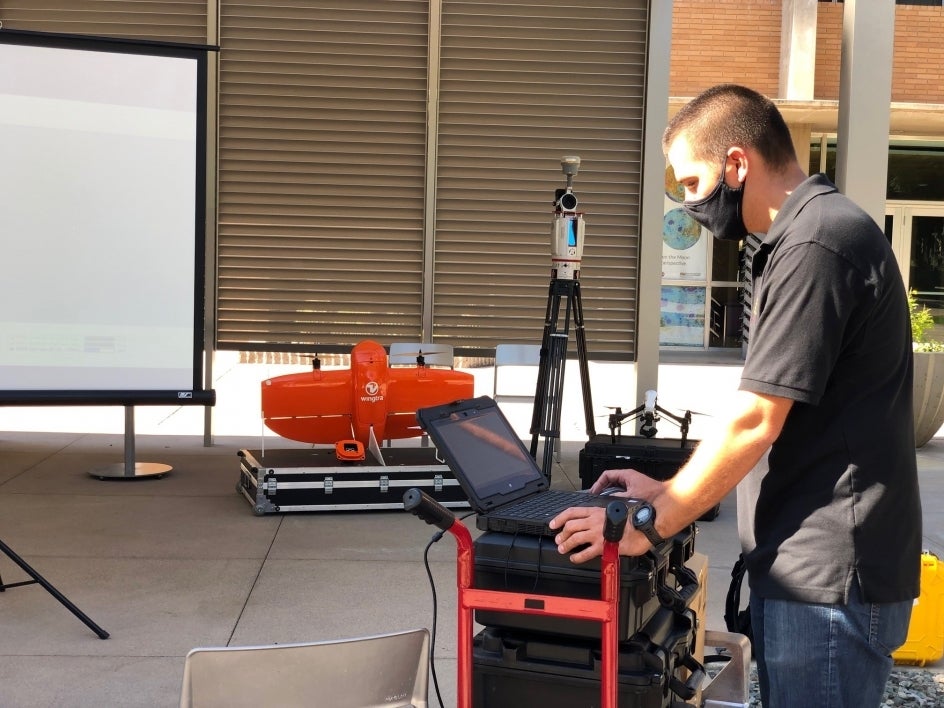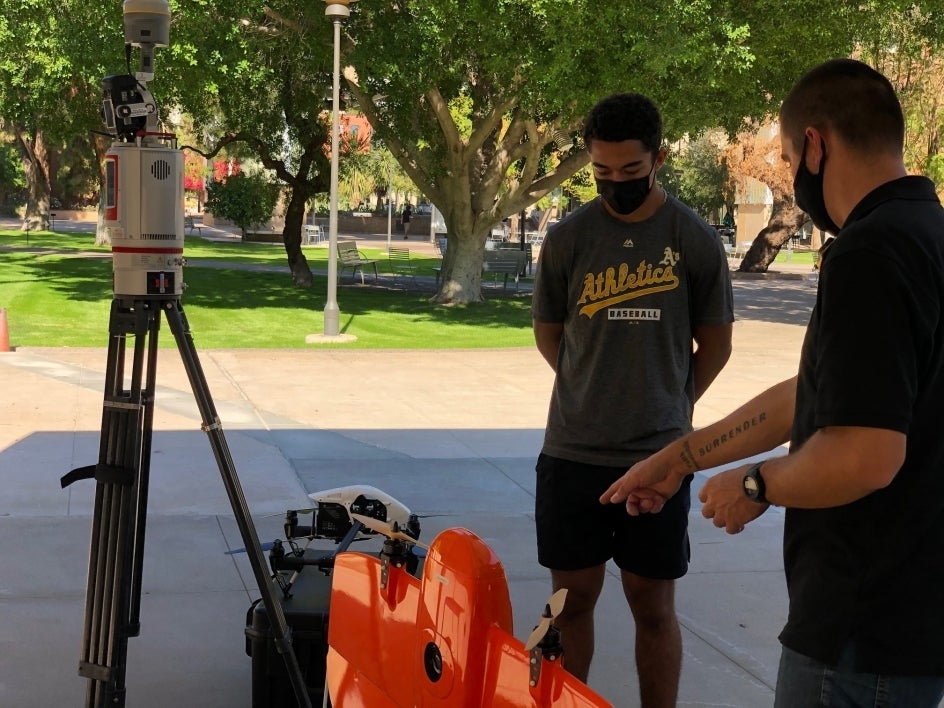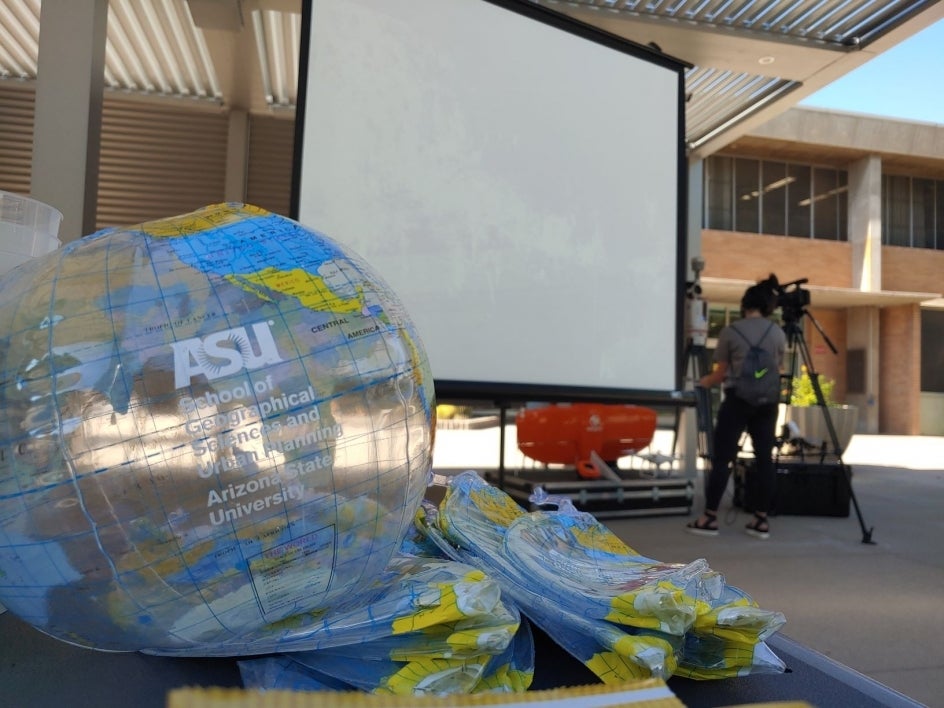ASU scientists, adventurers, explorers celebrate Geography Awareness Week

Craig Turner, holding one of the School of Geographical Sciences and Urban Planning's unmanned aerial vehicles. The school's terrestrial laser scanner is in the background.
Under a cloudless blue sky on Arizona State University’s Tempe campus, Craig Turner fired up a thin R2D2-looking device and shot out pulsed lasers creating a 3D map of ASU’s campus with impeccable detail — capturing everything from individual leaves on trees to the smallest hairline sidewalk cracks.
“Our lidar machine captures between 6 million to 20 million points in under a minute with the accuracy of less than a centimeter,” said Turner, laboratory coordinator in ASU’s School of Geographical Sciences and Urban Planning, to a group of students and staff. “Precise remote mapping technology like this allows us to monitor how landforms change over time, what causes these changes, and the efforts underway to preserve unique native environments.”
ASU’s School of Geographical Sciences and Urban Planning hosted a mixture of virtual activities and in-person, social-distanced events to celebrate Geography Awareness Week during the third week of November.
From masked-up outdoor presentations on unmanned aerial vehicles and terrestrial laser scanners to creating virtual spaces where students, alumni and faculty shared why geography inspired them, events were aimed at building community and igniting a shared love for exploration, investigation and storytelling of connections between people and place.
“I loved seeing everyone’s geography photography and hearing about their love for geography,” said Lucia Caraballo, an urban planning online student living in Virginia, via social media. “I’m so glad I found this program.”
Abigail Johnson, an ASU geography 2019 alumna, participated in the activities and shared in an online post that she loved geography for its different branches, including the physical, the human, and the environmental.
“I’ve applied my spatial perspectives to modern issues in local communities and environmental affairs. My education at the School of Geographical Sciences and Urban Planning has allowed me to move to graduate school,” Johnson wrote. “I will apply my geographic knowledge to provide culturally responsive teaching in my STEM classroom.”
A world interconnected
Often, outsiders may mistake the field of geography as studying points on a map, but the discipline is much more, and involves looking at the connections that exist in places and spaces.
For example, a place is much more than its rocks, its plants and its roads, but it also involves people, and all those individual elements associated with a place are interconnected.
“Geography is not about memorizing state capitals,” said Erinanne Saffell, a meteorologist and lecturer in the School of Geographical Sciences and Urban Planning. “It's about finding patterns in the natural world.”
Stewart Fotheringham, Regents Professor in the school, adds that because geography covers a variety of important topics, many of the decisions we make are influenced by space.
“Who we marry, where we live, who we vote for in elections, and where we shop are all heavily influenced by location,” Fotheringham said. “The field of geography is a chance to understand people's preferences and actions as they relate to our surroundings.”
“Discovering something new about issues that nobody else in the world knows is truly an amazing experience.”
While every personal geography story is different, a common trait among geographers is a shared inquisitive nature and deep drive to make a place better.
“Geography satisfies my curiosity about the world,” said Matthew Quick, assistant professor in the School of Geographical Sciences and Urban Planning. “It intersects with many different disciplines, can be used to answer many different types of research questions, and directly engages with the cities and neighborhoods that we live in.”
Kelli Larson, deputy director and professor in the school, agrees.
“I love the breadth of what geography is and what geographers do,” she said. “My specific field within geography is human-environment interactions, which provides the best of both words given my interest in how Earth systems work and why people do what they do.”
For Randall Cerveny, President’s Professor, his love for geography is summed up pretty simply, saying our world is “a pretty darn amazing place.”
Exploring the outdoors in a virtual world
Geography classes aren’t just for geography majors, but for anyone passionate about learning about the world and how it works.
Ronald Dorn, professor in the School of Geographical Sciences and Urban Planning, teaches GPH 111, an introduction to physical geography class at ASU focused on helping students interpret what they see when they visit the great outdoors — including the weather, the climate, the plants, the animals and scenery.
“The class and its lab explore what many students love to do with their free time — hike, kayak on rivers, mountain bike, or just go camping out in nature,” said Dorn, who has taught geography at ASU for more than 30 years and is an avid camper and skier. “You'll appreciate the outside world so much more after the classes.”
Unique to the course is the newly designed and launched geography "video game" lab. The video-game format lab (GPH 112) uses student avatars to investigate scientific issues related to climate, weather and landscapes in places like Hawaii, the Grand Canyon and San Francisco Peaks in Flagstaff, Arizona.
“The lab is a video game, I don’t know how else to describe it,” said Camille Plant, a journalism sophomore with a geography minor who took the course this semester, with a chuckle. “It’s interactive, you get this little character and they put you in different scenarios.”
“It’s been really interesting to learn about the science of the earth and how we interact with the world around us. My geography classes really have opened up a whole new world.”
The new video-game format lab was first launched in fall 2020 and is planned to continue into the spring 2021 semester as classes continue through a mixture of remote learning and in-person options.
Although physical exploration and travel may look different right now, Dorn is still passionate about sharing his love for geography with others and connecting students to the outdoors.
“I cannot wait to get the vaccine so I can run field trips for our students again. One of the first orders of business I want to do is a School of Geographical Sciences and Urban Planning campout to reconnect,” Dorn said. “If you care about the world and how we are connected to each other, geography is the field for you.”
More Science and technology

ASU professor honored with prestigious award for being a cybersecurity trailblazer
At first, he thought it was a drill.On Sept. 11, 2001, Gail-Joon Ahn sat in a conference room in Fort Meade, Maryland.…

Training stellar students to secure semiconductors
In the wetlands of King’s Bay, Georgia, the sail of a nuclear-powered Trident II Submarine laden with sophisticated computer…

ASU startup Crystal Sonic wins Natcast pitch competition
Crystal Sonic, an Arizona State University startup, won first place and $25,000 at the 2024 Natcast Startup Pitch Competition at…



